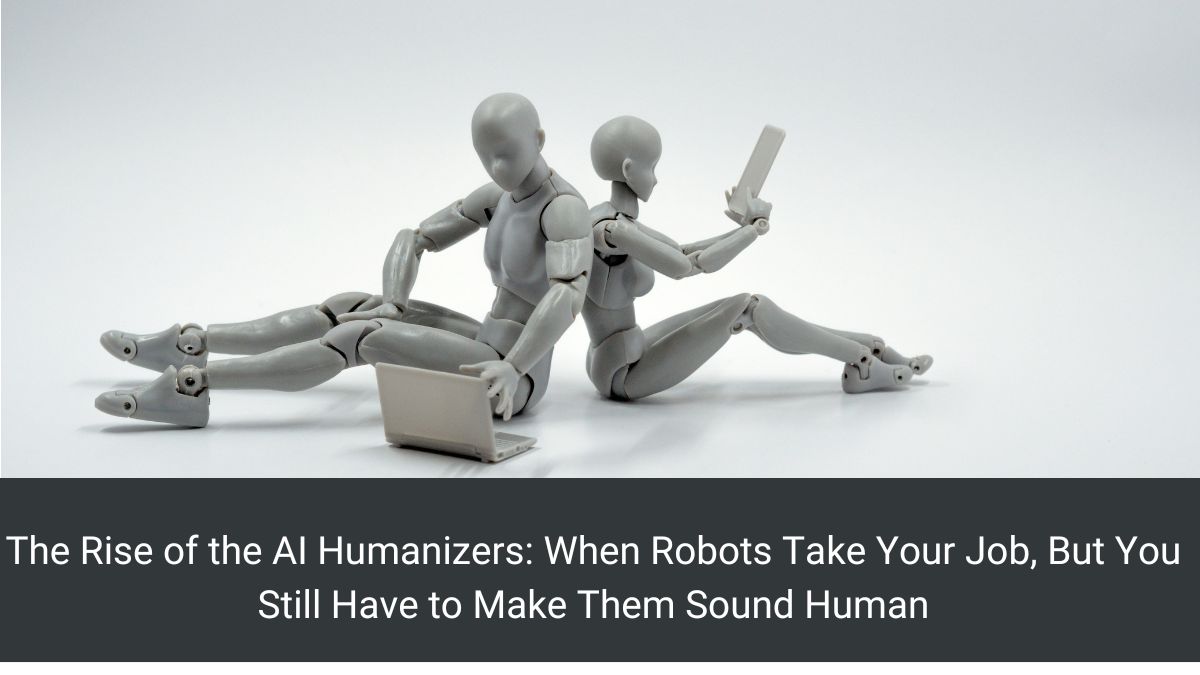AI
The Rise of the AI Humanizers: When Robots Take Your Job, But You Still Have to Make Them Sound Human

A New Era of Human-AI Collaboration
As artificial intelligence continues to permeate various industries, a peculiar phenomenon is emerging: the rise of the AI humanizers. These individuals, once thriving in their respective fields, now find themselves tasked with a unique responsibility – breathing life into the robotic outputs of the very technology that has displaced them.
The Copywriting Conundrum
The world of copywriting offers a poignant glimpse into this evolving dynamic. Writers like Benjamin Miller (a pseudonym), who once led a team of over 60 writers and editors, found themselves navigating a landscape transformed by AI’s arrival. Initially hailed as a cost-cutting measure, AI soon became an all-encompassing presence, relegating human writers to the role of editors – tasked with polishing and refining the machine-generated content.
“All of a sudden, I was just doing everyone’s job,” Miller recounts, his voice tinged with a hint of disbelief. “It was more editing than I had to do with human writers, but it was always the exact same kinds of edits. The real problem was it was just so repetitive and boring. It started to feel like I was the robot.”
A Personal Reflection: The Value of Human Creativity
As an avid writer and observer of the creative industries, I can’t help but feel a sense of unease at the prospect of human ingenuity being reduced to mere editing and polishing roles. The art of storytelling, the nuances of language, and the ability to evoke emotion – these are qualities that have long set human writers apart. To see them relegated to the sidelines, forced to shape and mold the output of soulless machines, is a sobering reminder of the potential downsides of unchecked technological advancement.
The Pursuit of Perfection, at What Cost?
The allure of AI-generated content lies in its promise of efficiency and cost-effectiveness. Yet, as companies chase these ideals, they often overlook the inherent flaws that plague the current generation of language models. From awkward phrasing to outright fabrications, AI’s shortcomings are numerous, requiring human intervention to ensure coherence and accuracy.
“We’re adding the ‘human touch,’ but that often requires a deep, developmental edit on a piece of writing,” explains Catrina Cowart, a copywriter from Lexington, Kentucky. “The grammar and word choice just sound weird. You’re always cutting out flowery words like ‘therefore’ and ‘nevertheless’ that don’t fit in casual writing. Plus, you have to fact-check the whole thing because AI just makes things up, which takes forever.”
Adding insult to injury, the very platforms that claim to detect and discourage AI-generated content are simultaneously hiring individuals like Cowart to “humanize” the robotic outputs, creating a paradoxical cycle of deception.
The Evolving Landscape of Work
As AI continues to advance, the lines between human and machine labor are becoming increasingly blurred. While some industries may experience a seamless integration of AI into their workflows, others, like copywriting, face a more turbulent transition.
Rebecca Dugas, an experienced copywriter, exemplifies the potential for harmonious human-AI collaboration. “It’s been an incredible co-creative partner,” she says, embracing AI as a tool to enhance her craft rather than replace it entirely.
However, for those in the early stages of their careers or working in the gig economy, the impact of AI can be far more severe. As Cowart attests, the tedious work of “humanizing” AI-generated content often comes with paltry compensation, a mere fraction of what traditional copywriting pays.
Navigating the Future of Work
The rise of the AI humanizers serves as a stark reminder of the complex challenges that lie ahead as we navigate the intersection of technology and human labor. While some view this transition as a natural evolution, akin to the advent of the automobile, others find themselves grappling with the harsh realities of job displacement and diminished earning potential.
As we move forward, it is imperative that we strike a delicate balance between embracing the efficiencies offered by AI and preserving the inherent value of human creativity and ingenuity. This may involve rethinking our approach to education and workforce development, equipping individuals with the skills necessary to thrive in a world where human-AI collaboration is the norm.
Moreover, we must address the ethical implications of this transition, ensuring that the pursuit of technological advancement does not come at the cost of exploiting human labor or devaluing the very qualities that make us unique.
In the words of Bars Juhasz, chief executive of Undetectable AI, “People who can learn to work with the technology are going to be OK.” While this statement may ring true for some, it is our collective responsibility to ensure that the path to this future is paved with fairness, dignity, and respect for the human experience.
As we navigate this uncharted territory, let us embrace the lessons learned from the rise of the AI humanizers, recognizing that the true measure of progress lies not solely in technological prowess but in our ability to harmonize innovation with the enduring values that define our shared humanity.
